Master Time Management and Achieve Your Goals with Expert Planning Techniques
In today’s fast world, managing our time is key to success. But how do we control our days and make the most of every moment? Daily planners hold the answer.
Are you juggling many tasks and feeling overwhelmed? Daily planners can change your productivity and help you reach your goals easily.
Some articles on this site contain affiliate links, which means I may earn a small commission at no extra cost to you if you make a purchase through these links. Additionally, some images on this site are AI-generated for illustrative purposes.
Thank you for supporting our content!
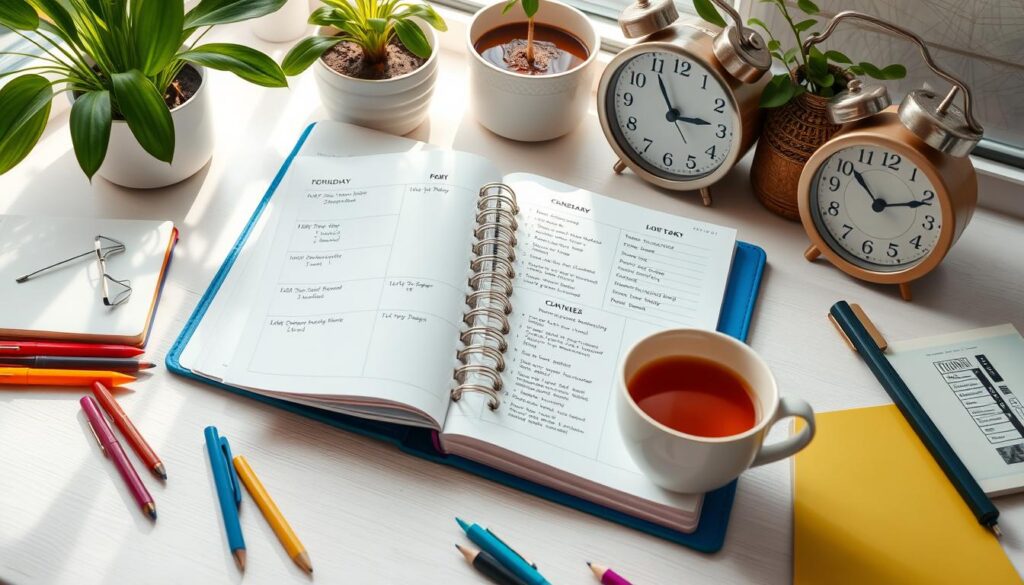
Key Takeaways
- Understand the benefits of structured time management for personal and professional growth
- Explore the psychology behind effective planning and its impact on productivity
- Discover the essential features of an efficient daily planner
- Learn how to create morning and evening planning rituals for maximum efficiency
- Explore the pros and cons of digital versus paper planners to find the right tool for your needs
Some articles on this site contain affiliate links, which means I may earn a small commission at no extra cost to you if you make a purchase through these links. Additionally, some images on this site are AI-generated for illustrative purposes.
Thank you for supporting my content!
Be sure to check out our premium planners to help you get started on your time management journey!
Understanding the Power of Daily Planning for Success
Effective time management is key for growth. Daily planning opens doors to many benefits. It boosts productivity and helps balance work and life.
Benefits of Structured Time Management
Structured time management boosts your efficiency and well-being. Daily planning lets you focus on what’s important. It also cuts down stress and distractions.
Psychology Behind Effective Planning
Planning taps into our need for control and success. It makes us feel good by releasing dopamine. This keeps us motivated and growing.
Impact on Personal and Professional Growth
Daily planning changes your life for the better. Productivity apps and goal-setting help balance work and life. They let you grow and achieve in all areas.
“The key is not to prioritize what’s on your schedule, but to schedule your priorities.” – Stephen R. Covey
Essential Features of an Effective Daily Planner
Starting a productive day needs the right tool – a good daily planner. These planners help you keep up with your yearly goals, monthly milestones, and habit trackers. Let’s look at what makes a planner great.
A top daily planner lets you see and plan your yearly goals. It has a special section for your big dreams. You can break them down into smaller steps and track your progress all year.
Next, a good planner has spots for monthly milestones. These help you stay focused and see how you’re doing. They make sure you’re always moving towards your big goals.
| Feature | Benefit |
|---|---|
| Yearly Goals Section | Visualize and plan long-term aspirations |
| Monthly Milestones | Stay focused and measure progress |
| Habit Trackers | Build sustainable routines and achieve personal growth |
Lastly, a great planner has habit trackers. These let you track your daily and weekly habits. They help you grow personally and professionally.
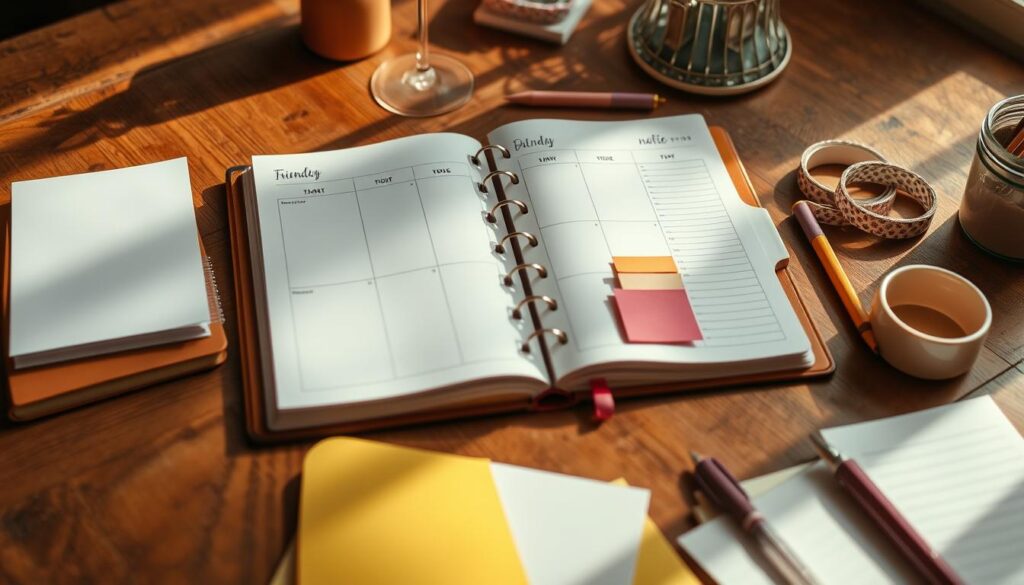
With these key features, a daily planner is a powerful tool. It keeps you organized, focused, and on track to your yearly goals, monthly milestones, and habit goals.
Time Management Master your schedule with planners for daily and week
Effective time management is key to reaching your full ability. Daily and weekly planners help you control your schedule and focus on what’s important. This part talks about morning planning, evening checks, and weekly planning. It uses calendar tools and task prioritization to help.
Morning Planning Rituals
Begin your day right with a morning planning routine. Spend a few minutes each morning to look at your schedule and set priorities. Use your daily planner to organize tasks and set deadlines. This keeps you focused and productive all day.

Evening Review Sessions
At the end of the day, reflect on what you did and plan for tomorrow. Use your planner to check your progress, see what’s left, and adjust your schedule. This evening review helps you finish tasks, prepare for tomorrow, and stay in control.
Weekly Planning Strategies
- Make time each week to review your calendar and plan for the next days.
- Look at any deadlines, events, or commitments coming up and plan your time.
- Use the Eisenhower Matrix or a similar method to prioritize your tasks.
- Make a weekly overview in your planner to keep a clear view of your schedule.
By using these daily and weekly planning tips, you’ll get better at managing your time. You’ll achieve your goals more efficiently and stay focused.
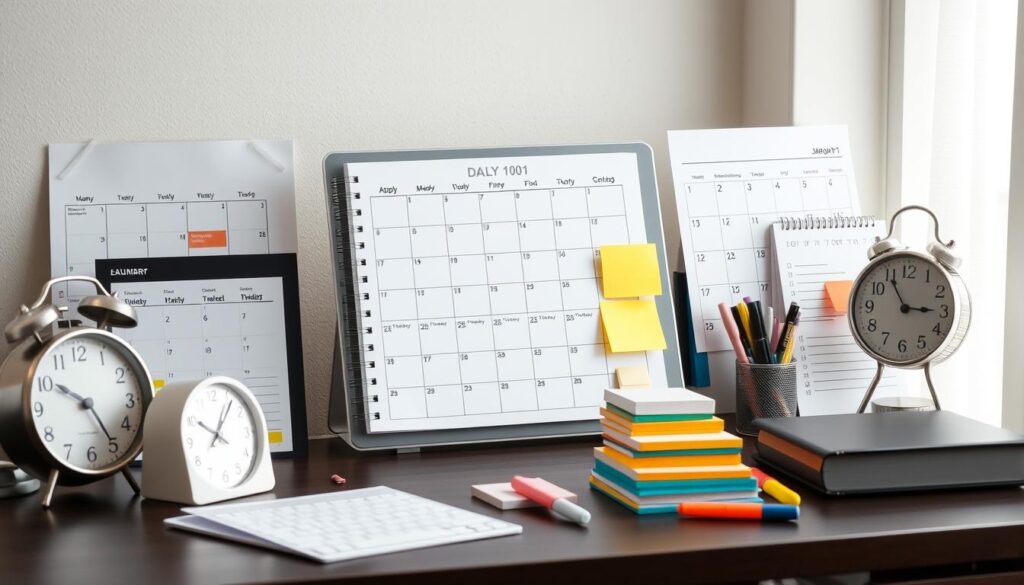
Digital vs. Paper Planners: Choosing the Right Tool
In today’s world, we face a big choice: paper or digital planners. Each has its own benefits. Your choice depends on what you like and need. Let’s look at what to think about when picking a planner.
The Allure of Budget-Friendly Printable Planners
If you’re watching your spending, printable planners are a smart pick. These budget-friendly printable planners let you pick from many templates. You can print them at home, making your planner just right for you without spending a lot.
The Power of Productivity Apps
Digital planners, or productivity apps, change how we manage our time. They sync with your calendar, help you set priorities and track habits. Many are free or cheap, making them great for digital organizations.
When picking between paper and digital planners, think about how you learn, how mobile you need to be, and how much you want to customize. Paper planners give a real, hands-on feel. Digital ones offer more features and let you access your schedule anywhere.
“The key is not to prioritize what’s on your schedule, but to schedule your priorities.” – Stephen R. Covey
Choosing between budget-friendly printable planners and productivity apps depends on what you prefer and need daily. Try both to find what works best for you and reach your goals.
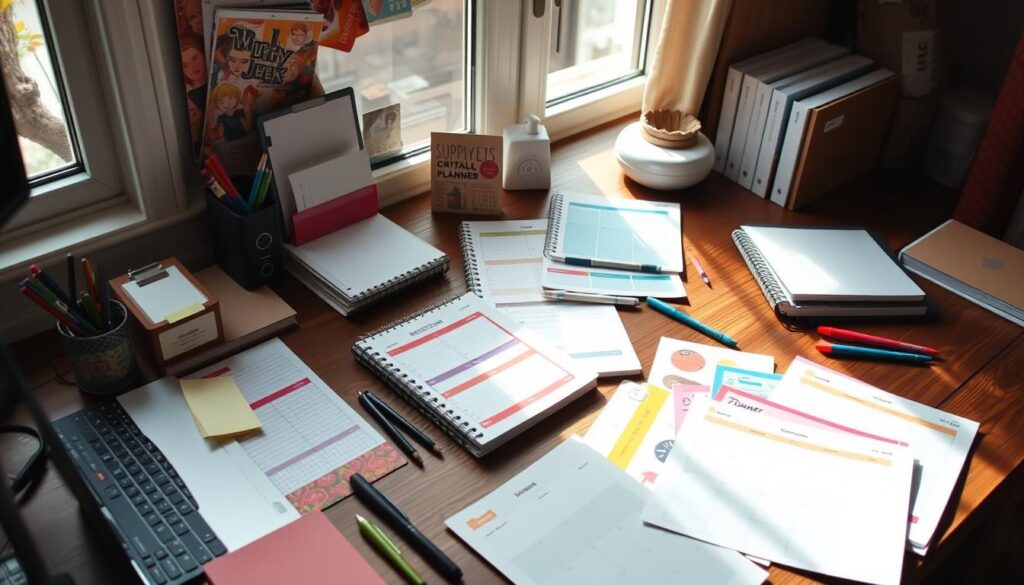
Goal Setting and Task Prioritization Techniques
Good time management is more than just planning your day. It’s about setting clear goals and focusing on what’s most important. Using smart goal-setting and task prioritization can boost your productivity and help you succeed.
SMART Goal Implementation
The SMART method is a powerful way to set goals. SMART goals are Specific, Measurable, Achievable, Relevant, and Time-bound. This method helps you create a clear plan and track your progress well.
Eisenhower Matrix for Task Management
The Eisenhower Matrix is a simple yet effective tool for task prioritization. It sorts tasks into four areas based on urgency and importance. This helps you focus on what’s most critical and manage your time better.
Breaking Down Large Projects
Big projects can feel overwhelming. But breaking them down into smaller steps makes them more manageable. Use your planners to divide big goals into smaller tasks. This makes tracking your progress easier.
| Goal Setting Technique | Description | Benefits |
|---|---|---|
| SMART Goals | A framework for setting specific, measurable, achievable, relevant, and time-bound goals. | Provides a clear roadmap for success and enables easier progress tracking. |
| Eisenhower Matrix | A tool for prioritizing tasks based on their urgency and importance. | Helps you focus on the most critical activities and delegate or eliminate less essential tasks. |
| Breaking Down Large Projects | Dividing large, complex goals into smaller, actionable tasks. | Makes it easier to track progress and stay on top of your workload. |
Mastering these techniques and using them in your planners can elevate your time management. You’ll achieve your goals more efficiently and successfully.
Time Blocking: Maximizing Your Daily Schedule
Time blocking is a key strategy for being more productive. It means setting aside specific times for different tasks. This way, you can focus better and get more done in less time.
The Pomodoro Technique is a well-known method of time blocking. It suggests working in 25-minute bursts and then taking short breaks. This keeps you focused and stops you from getting too tired.
- Plan your day in advance, dividing it into specific time blocks for tasks, breaks, and essential activities.
- Prioritize your most important or challenging tasks, and allocate focused time blocks to tackle them.
- Minimize distractions by silencing notifications and creating a distraction-free environment during your time-blocked sessions.
- Embrace the Pomodoro Technique, cycling between 25-minute work periods and short breaks to maintain concentration and energy levels.
- Regularly review and adjust your time blocks based on evolving priorities and unexpected interruptions.
Using time blocking and the Pomodoro Technique can change your day. You’ll be more productive and achieve your goals faster.
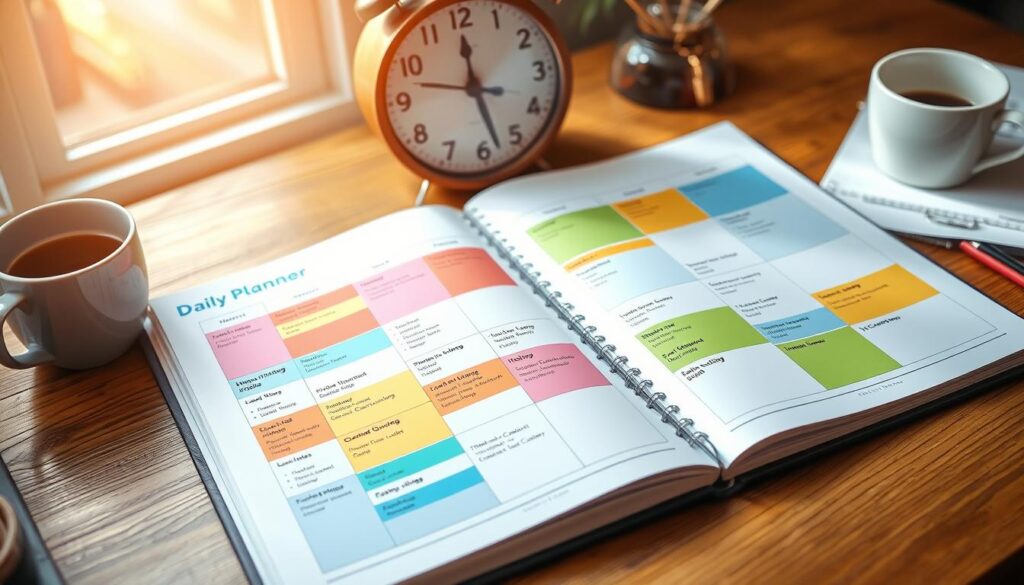
Integrating Habit Trackers and Productivity Tools
In today’s fast world, staying productive and building good habits is hard. But, using habit trackers and apps can help. They make your daily tasks easier and help you reach your goals faster.
Building Sustainable Habits
Creating lasting change starts with good habits. Habit trackers help you keep track and stay on course. They let you see your progress, celebrate wins, and tweak your routine when needed.
Progress Monitoring Methods
- Use a habit tracker app to log your daily activities and monitor your progress.
- Create a simple paper-based habit tracker to visually track your progress.
- Set reminders and notifications to ensure you stay on track with your habits.
Productivity Apps Integration
Productivity apps make your daily planning better. They help you manage time and tasks. Apps like these reduce distractions and keep you organized all day.
| Productivity App | Key Features | Benefits |
|---|---|---|
| Trello | Kanban-style task management Customizable boards and lists Collaboration and file sharing | Visualize your workflow Streamline project management Enhance team collaboration |
| Notion | All-in-one workspace Note-taking and documentation Task management and project planning | Centralize your work in one place Improve information organization Boost productivity and efficiency |
By using habit trackers and productivity tools, you can plan better. This helps you grow personally and professionally. These digital tools help you build lasting habits and boost your productivity.
Work-Life Balance Through Strategic Planning
Getting a good work-life balance is hard in today’s fast world. But, with smart planning and time management, it’s doable. You can find a balance between work and personal life.
One smart move is to delegate. Give tasks to your team or outsource them. This saves you time and helps your team grow. It makes work better and more fun for everyone.
Time blocking is also key. Set times for work, fun, and taking care of yourself. This keeps your life organized. It helps you stay focused and keep work and personal life separate.
“The key to work-life balance is to set boundaries and stick to them. It’s about prioritizing what’s truly important and saying no to the things that don’t align with your goals.” – Jane Doe, Productivity Strategist
It’s also important to have healthy habits. This means exercise, mindfulness, and enough sleep and food. Taking care of yourself helps you handle work and personal life better.
Getting a work-life balance is a journey. You might need to change your plans as things change. By using delegation strategies and time management, you can live a better life. Both at work and at home.
Budget-Friendly Planner Options and Resources
Keeping organized doesn’t have to cost a lot. There are many affordable planner options and resources. You can find free printable templates and digital solutions that won’t hurt your wallet.
Free Printable Planning Templates
Looking for a cheap way to stay organized? Check out the free printable planning templates online. You can customize them to fit your needs. Whether you need daily, weekly, or monthly layouts, you can find them.
Just download, print, and start organizing your time and tasks. It’s easy and free.
Cost-Effective Digital Solutions
There are also affordable digital planner apps and software. You can find subscription-based digital planners and free mobile apps. They offer features like task management, habit tracking, and goal-setting tools.
When choosing a planner, think about what you need. Look for something that’s affordable, customizable, or both. With the right tools, you can manage your schedule and reach your goals without spending too much.
Common Planning Pitfalls and How to Avoid Them
Using a planner to organize your life needs some skill. Many people face common planning problems that can mess up their plans. We’ll look at these issues and share tips to avoid them.
Overscheduling and Unrealistic Expectations
One big problem is trying to do too much in one day. This can make you stressed and feel like you’ve failed. To fix this, make a schedule that’s balanced and flexible.
Lack of Prioritization
When your planner is full, it’s hard to know what to do first. Use a system like the Eisenhower Matrix to focus on the most important tasks.
Neglecting Regular Reviews
Planning is an ongoing task, not just a one-time thing. Not checking your planner regularly can cause missed deadlines and lost tasks. Make time each week or day to review your plans and celebrate your wins.
| Common Planning Pitfalls | Strategies to Avoid Them |
|---|---|
| Overscheduling and Unrealistic Expectations | Create a balanced schedule with room for flexibility |
| Lack of Prioritization | Implement a system like the Eisenhower Matrix to prioritize tasks |
| Neglecting Regular Reviews | Set aside time for weekly or daily planner reviews |
By knowing these common problems and using the right strategies, you can use a planner to organize your busy life better. The secret to good planning is being flexible, focusing on what’s important, and regularly checking your plans.
Conclusion
Mastering your schedule with daily and weekly planners is key to success. It helps in both your personal and work life. By using structured time management, you can control your time better.
Choosing between digital or paper planners is important. Find one that fits your needs and style. Setting SMART goals and using time-blocking can help you stay on track.
Time management is not the same for everyone. You need to try different methods to find what works for you. Keep learning and adapting. This will help you be more productive and balanced.






